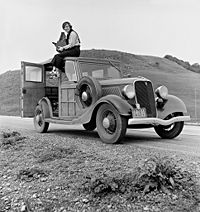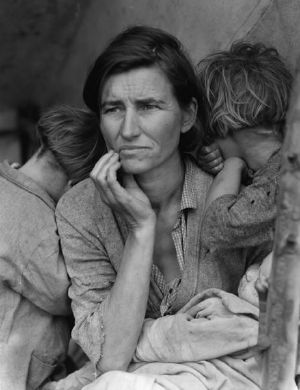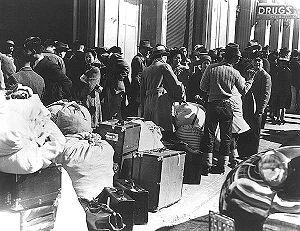Dorothea Lange
| Dorothea Lange | |
 Dorothea Lange in 1936; photographer
| |
| Occupation | American photographer, Documentary Photographer Photojournalist |
|---|---|
| Spouse(s) | Maynard Dixon (1920-1935) Paul Schuster Taylor (1935-1965) |
| Children | Daniel and John Dixon |
Dorothea Lange (May 25 1895 – October 11 1965) was an influential American documentary photographer and photojournalist, best known for her Depression-era work for the Farm Security Administration (FSA). Lange's photographs humanized the tragic consequences of the Great Depression and profoundly influenced the development of documentary photography.
Early life and career
Born in Hoboken, New Jersey, her birth name was Dorothea Margarette Nutzhorn. She eventually dropped her middle and last names, adopting her mother's maiden name of Lange. Lange developed polio in 1902, at age 7. Like many other polio victims before treatment was available, Lange emerged with a weakened and wizened right leg and dropped foot. Although she compensated well for her disability, she always limped.
Lange once commented on her disability saying,
I was physically disabled, and no one who hasn't lived the life of a semi-cripple knows how much that means. I think it perhaps was the most important thing that happened to me, and formed me, guided me, insructed me, helped me, and humuliated me. All those things at once.[1]
Lange learned photography in New York City in a class taught by Clarence H. White and informally apprenticed herself to several New York photography studios, including that of the famed Arnold Genthe. In 1918, she moved to San Francisco, where she opened a successful portrait studio. She lived across the bay in Berkeley for the rest of her life. In 1920, she married the noted western painter Maynard Dixon, with whom she had two sons: Daniel, born 1925, and John, born 1928.[2]
Photography and the Great Depression
With the onset of the Great Depression, Lange turned her camera lens from the studio to the street. Her studies of unemployed and homeless people captured the attention of local photographers and led to her employment with the federal Resettlement Administration (RA), later called the Farm Security Administration (FSA).
In December 1935, she divorced Dixon and married agricultural economist Paul Schuster Taylor, Professor of Economics at the University of California, Berkeley.[2] Taylor educated Lange in social and political matters, and together they documented rural poverty and the exploitation of sharecroppers and migrant laborers for the next five years — Taylor interviewing and gathering economic data, Lange taking photos.
From 1935 to 1939, Lange's work for the RA and FSA brought the plight of the poor and forgotten — particularly sharecroppers, displaced farm families, and migrant workers — to public attention. Distributed free to newspapers across the country, her poignant images became icons of the era.
Lange's most well-known picture is titled "Migrant Mother." The woman in the photo is Florence Owens Thompson, but Lange apparently never knew her name.
In 1960, Lange spoke about her experience taking the photograph:
- I saw and approached the hungry and desperate mother, as if drawn by a magnet. I do not remember how I explained my presence or my camera to her, but I do remember she asked me no questions. I made five exposures, working closer and closer from the same direction. I did not ask her name or her history. She told me her age, that she was thirty-two. She said that they had been living on frozen vegetables from the surrounding fields, and birds that the children killed. She had just sold the tires from her car to buy food. There she sat in that lean-to tent with her children huddled around her, and seemed to know that my pictures might help her, and so she helped me. There was a sort of equality about it.
According to Thompson's son, Lange got some details of this story wrong,[3] but the impact of the picture was based on the image showing the strength and need of migrant workers.
Photographing internment camps: World War II
In 1941, Lange was awarded a Guggenheim Fellowship for excellence in photography. After the attack on Pearl Harbor, she gave up the prestigious award to record the forced evacuation of Japanese-Americans (Nisei) to relocation camps in the American West, on assignment for the War Relocation Authority (WRA). She covered the rounding up of Japanese Americans, their evacuation into temporary assembly centers, and Manzanar, the first of the permanent internment camps. To many observers, her photograph of young Japanese-American girls pledging allegiance to the flag shortly before they were sent to internment camps is a haunting reminder of this policy of detaining people without charging them with any crime or affording them any appeal.
Her images were so obviously critical that the Army impounded them. Today her photographs of the internment are available in the National Archives on the website of the Still Photographs Division, and at the Bancroft Library of the University of California, Berkeley.
End of life and Legacy
On her technique Lange once commented,
For me documentary photography is less a matter of subject and more a matter of approach. The important thing is not what's photographed, but how.... My own approach is based upon three considerations. First - hands off! Whatever I photograph, I do not molest or tamper with or arrange. Second - a sense of place. Whatever I photograph, I try to picture as part of its surroundings, as having roots. Third - a sense of time. Whatever I photograph, I try to show as having its position in the past or in the present.[4]
In 1952, Lange co-founded the photographic magazine Aperture. In the last two decades of her life, Lange's health was poor. She suffered from gastric problems, including bleeding ulcers, as well as post-polio syndrome — although this renewal of the pain and weakness of polio was not yet recognized by most physicians. She died of esophageal cancer on October 11, 1965, aged 70.[2]
Lange was survived by her second husband, Paul Taylor, two children, three step-children, and numerous grandchildren and great-grandchildren.
Notes
- ↑ Davis, Keith F. Dorothea Lange, Hallmark Cards/Abrams, New York, 1995
- ↑ 2.0 2.1 2.2 Oliver, Susan (2003-12-07). Profile of Dorothea Lange. Dorothea Lange: Photographer of the People. Retrieved 2007-06-17.
- ↑ Dunne, Geoffrey, "Photographic license", New Times, 2002.
- ↑ Davis, Keith F. Dorothea Lange, Hallmark Cards/Abrams, New York, 1995
ReferencesISBN links support NWE through referral fees
- Davis, Keith F. Dorothea Lange, Hallmark Cards/Abrams, New York, 1995 ISBN 0-8109-6315-9
- Dunne, Geoffrey, "Untitled Depression Documentary" 1980
- Gordon, Linda , Dorothea Lange, Encyclopedia of the Depression
- Gordon, Linda, Paul Schuster Taylor, American National Biography
- Gordon, Linda and Gary Okihiro, Impounded: Dorothea Lange and the Censored Images of Japanese American Internment
- Meltzer, Meltzer, Dorothea Lange: A Photographer's Life New York, 1978.
External links
- Khasnis, Gridhar. The Hindu. 2006;"Article About Migrant Mother: The True Story". The Hindu. Retrieved September 1, 2007.
- "Dorothea Lange - "A Photographers Journey"". Gendell Gallery. Retrieved September 1, 2007.
- Doud, Richard K. AAA. 1964"Dorothea Lange Oral History Interview". Smithsonian Archives of American Art. Retrieved September 1, 2007.
- "'Migrant Mother', an Essay on Liberal Propaganda". Capital Flow Analysis. Retrieved September 1, 2007.
- "Dorothea Lange Collections", Oakland Museum of California. Retrieved September 1, 2007.
- "Gallery of all Lange FSA photographs". Library of Congress. Retrieved September 1, 2007.
- "Dorothea Lange- Selection of photographs". Victoria and Albert Museum. Retrieved September 1, 2007.
- [1] Civil Control Station, Registration for evacuation and processing. San Francisco, April 1942. War Relocation Authority, Photo By Dorothea Lange,From the National Archive and Records Administration taken for the War Relocation Authority courtesy of the Bancroft Library, U.C. Berkeley, California. Published in Image and Imagination, Encounters with the Photography of Dorothea Lange, Edited by Ben Clarke, Freedom Voices, San Francisco, 1997
- [2] Pledge of allegiance at Rafael Weill Elementary School a few weeks prior to evacuation, April, 1942. N.A.R.A.; 14GA-78 From the National Archive and Records Administration taken for the War Relocation Authority courtesy of the Bancroft Library. Published in Image and Imagination, Encounters with the Photography of Dorothea Lange, Edited by Ben Clarke, Freedom Voices, San Francisco, 1997
Credits
New World Encyclopedia writers and editors rewrote and completed the Wikipedia article in accordance with New World Encyclopedia standards. This article abides by terms of the Creative Commons CC-by-sa 3.0 License (CC-by-sa), which may be used and disseminated with proper attribution. Credit is due under the terms of this license that can reference both the New World Encyclopedia contributors and the selfless volunteer contributors of the Wikimedia Foundation. To cite this article click here for a list of acceptable citing formats.The history of earlier contributions by wikipedians is accessible to researchers here:
The history of this article since it was imported to New World Encyclopedia:
Note: Some restrictions may apply to use of individual images which are separately licensed.

